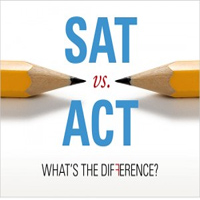The ACT and SAT are both widely accepted by U.S. colleges, which often leads students to ask: Which test should I take? High school Juniors (11th) grade students can decide to take either ACT in Feb or SAT in March.
According to College Board data, 1.7 million high school students took the SAT at least once in the class of 2022, a slight increase from 1.5 million students in the previous class. In the class of 2022, nearly 1.35 million students took the ACT.
There is no difference in difficulty between the SAT and the ACT. Each individual has a choice, a preference, and a level of difficulty that determines whether to take either course. We will compare the ACT and SAT exams in this blog and identify the differences between them.
ACT Overview:
The ACT is a college entrance exam that many colleges and universities in the United States use as part of the college admissions process. The ACT is a standardized test that assesses students’ skills in five core areas: English, Math, Reading, Science, and Writing (optional). From the date of testing, ACT scores are valid for five years.
ACT Scoring System:

- Subject Score: There are 4 subject scaled scores.
- Grouped Score: STEM (Maths + Science) and ELA (English + Reading + Essay*).
- Composite Score: Average of all subjects (English + Math + Reading + Science) scaled score.
*If you take the ACT with Writing, then your essay will not be factored into the composite score.
NA – Not Applicable
SAT Overview:
Colleges and universities generally consider the SAT in the admissions process as a standardized test for high school students. These students can take the test from 9th to 12th grade. In junior year, most students take the test. Since high school junior and senior years are busy it’s hard for students to keep up with all the activities.
SAT Scoring System:

- Test/Subject Score: There is 4 subjects’ scaled score.
- Section/Grouped Score: EBRW- Evidence-Based Reading and Writing (Reading + Writing & Language) and Math Composite (Math).
- SAT Total Score: {(Reading Scale Score + Writing & Language Scale Score) *10 + Math*20} or (EBRW + Math) Section Scores.
* If you take the SAT with an essay, your essay will not factor into the Total or Section scores.
SAT vs. ACT Structural Differences
| ACT | SAT | |
| Number of Question | 215 | 154 |
| Length of Assessment | 3 hours 35 minutes | 3 hours 15 minutes |
| Scoring Scale | 1-36 | 400-1600 |
| Sections | Math (Calculator and Non-Calculator), Reading, and Writing | Math, Reading, Writing, and Optional Essay |
| Test Dates | Four times per year – March, May, October, and December | Six times per year – February, April, June, July, September, and October |
Here is a list of the distinct differences:
Time Per Section:
Test sections are given varying amounts of time. On the SAT, more time is allotted to each question than on the ACT. Compared to the ACT, this test allows you more time per question. In reading, for instance, the ACT gives you 53 seconds per question, while the SAT gives you 75 seconds per question. On the ACT, there is a 36-second time limit per question, while on the SAT, there is a 48-second time limit per question. On the SAT, you are given more time per question.
Range of Scores:
The ACT scores each section on a scale of 1-36, while the SAT scores each section on a scale of 200-400, with a total score ranging from 400-1600 points.
The Science and Math Sections:
The ACT features a unique section: the science section. The SAT and ACT contain sections devoted to reading and writing, but the SAT contains two mathematics sections (one with a calculator and one without), while the ACT contains one math and one science section.
Both tests have outstanding math sections. Neither test focuses heavily on algebra, but like the SAT, the ACT also includes a section on geometry and trigonometry, and the ACT allows calculators for all sections (whereas the SAT has only one math section that does not).
Command of Evidence Questions:
A major difference between the two tests is how the questions are arranged. SAT reading section includes a unique sub-section that asks you to support your claim with evidence, and each question is chronologically ordered according to the text it references. Evidence-based questions are not included in the ACT and they are arranged randomly in accordance with the paragraph they reference.
SAT vs. ACT Score Conversion:
Students interested in comparing scores on the SAT and ACT can access conversion charts from the College Board and ACT organizations.
A total score of 400 to 1600 can be achieved on the SAT; a composite score of 1 to 36 can be achieved on the ACT. In addition to the ACT writing test, which is scored separately, those ranges do not include the optional ACT writing test.
It’s a big step to take the ACT or SAT! The key to success is proper preparation, sheer determination, and a strong sense of discipline.
To learn more about the SAT vs. ACT Predictor test please check the website: https://satactorboth.socrato.com/.
Please check the Socrato youtube channel to grade SAT or ACT practice bubble sheet online. Download Socrato’s free ebook to learn the strategy to score high in SAT or ACT exams. Moreover, there are Diagnostic reports of 9 pages as well as the Subject level analysis.










